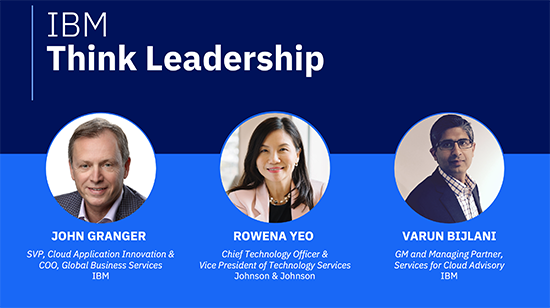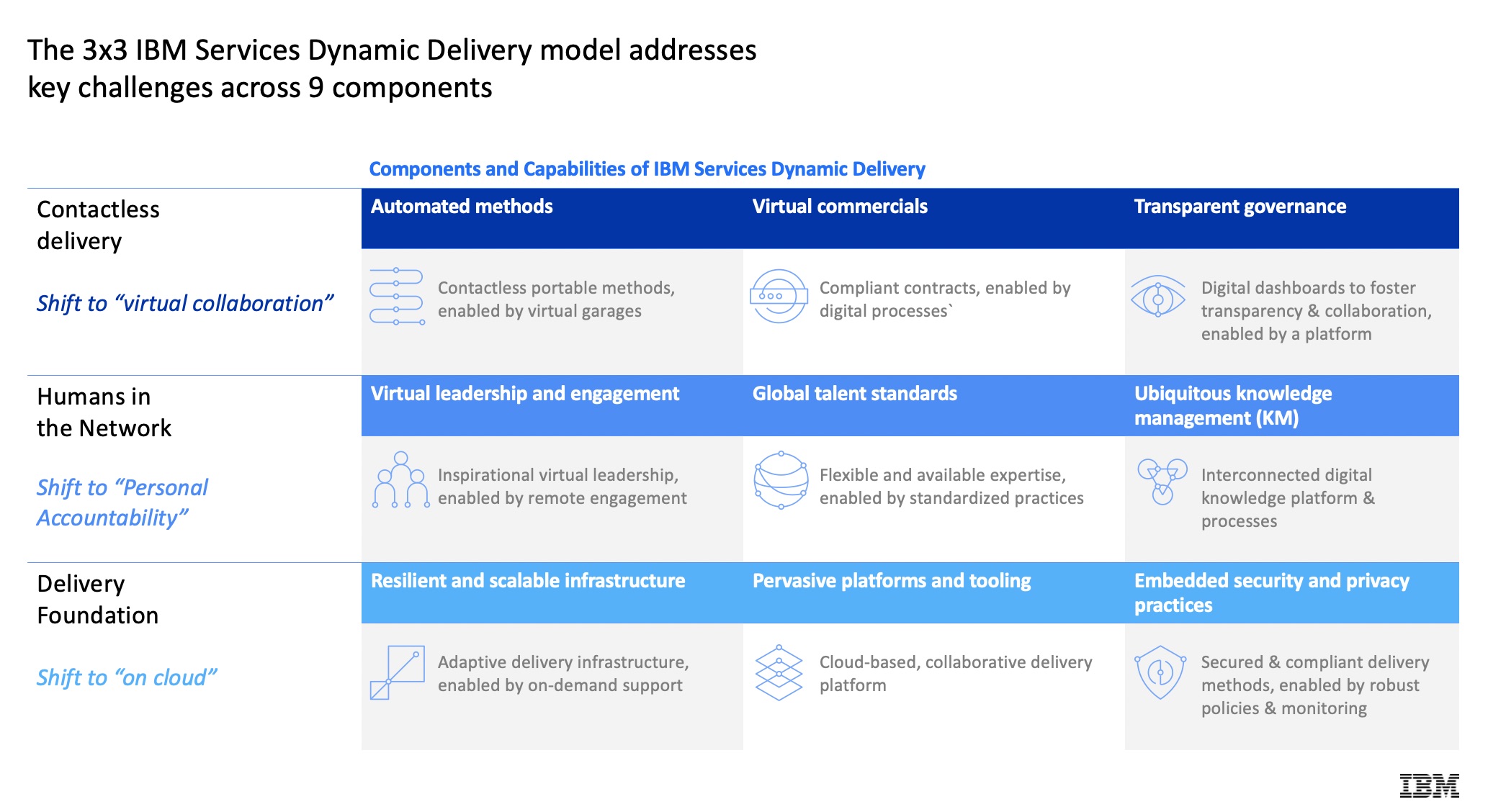IBM and Coronavirus stories
A Service Delivery Model Forged by Necessity May Have a Lasting Impact
By Trish Hall
For individuals, the pandemic has changed everything, in ways small—wearing a mask when leaving the house—and big, like working at home all day or having to primarily connect virtually with colleagues, family and friends.
For businesses, the changes have been even more profound, requiring a new digitally driven approach to how work gets done that IBM has dubbed “dynamic delivery,” according to John Granger, Senior Vice President, Cloud Application Innovation and COO, IBM Global Business Services.
Granger discussed that emerging model in a conversation, released as a livestream video, with the chief technology officer of the medical products company Johnson & Johnson, Rowena Yeo, and an IBM colleague, Varun Bijlani.

Watch highlights from the livestream
In the beginning of the crisis, Granger said, the focus was on maintaining continuity and resiliency with the IT and business services that power companies’ most critical business operations. But now the desire is to apply lessons learned to create a new model of service delivery that will endure long past the pandemic—a comprehensive approach that takes into account the technology, new ways of working and methods that are needed to deliver digital transformation despite disruption.
“With the advent of the COVID-19 pandemic, it is now more critical than ever to innovate with technology to respond to the current global health crisis while continuing to serve our patients and customers,” said Yeo, Chief Technology Officer and Vice President, Technology Services of Johnson & Johnson.
According to Yeo: “We had to be much more agile in the way we manage our technology environment and in the way we deliver and scale our services. It’s definitely a much broader challenge as we look at how to motivate people, share knowledge, drive new work patterns and drive innovation while in a virtual environment.”
Suddenly supporting their workforce and over 130,000 computers while remote was a challenge, she said. Almost immediately when the pandemic began, Johnson & Johnson arranged for additional cloud capacity, assessed network resiliency and bought extra laptops to make sure critical systems would be well supported.
Johnson & Johnson also worked together with IBM to ensure continuity for critical business functions, even as the IBM team shifted to work remotely. According to Yeo, “IBM has provided seamless support across more than 200 applications including core systems like supply chain, HR/payroll and other corporate services.”
Bijlani, GM and Managing Partner, IBM Services for Cloud Advisory, said he’s seen the way the coronavirus crisis has functioned as an accelerator to IBM’s own delivery transformation. The company moved more than 50 large-scale projects to a virtual-first model and handled more than a million service requests in three months alone.
“We made progress of almost two years in six weeks,” Bijlani said. “With these learnings we are looking to harden this capability into a holistic framework we refer to as Dynamic Delivery.”
The Dynamic Delivery model requires orchestration of three key building blocks: enhanced and automated processes for contactless delivery, deep thinking about how we function as humans in the network and the latest delivery foundation.

The Next Generation of Delivery
What sets this approach apart, Granger said, is that it looks across every aspect of what needs to change in service delivery to suit the challenges of the new normal. “This is so much more than just moving people to working from home,” he said. “It’s much deeper than that.”
In day to day terms, Yeo said, that means everything from responding quickly to fluctuations in consumer demand with automated scenario risk simulation technology, to enabling digital interactions with healthcare professionals and patients around the world to minimize disruption to clinical trials. And through it all, innovation cannot be lost.
One of the solutions IBM has found to the challenge of sustaining innovation is moving its IBM Garage, where it creates, executes and scales solutions with clients, onto a virtual platform. “It’s that collaborative process to build a minimum viable product in a very short time, pulling down technologies, putting them together in very close connection with the business,’’ Granger said, “and all of that that that can still be done in a virtual way.”
For one small example, in an in-person garage collaboration, he said, you can see who is engaged. In the virtual form, quizzes and polls are used as you go along to make sure people are still with you and excited.
“That virtual garage is really important in providing that magic sauce, if you like, that helps to ensure that the creativity is sustained,’’ Granger said. “It also enables us to pull in talent from all over the world.”
Yeo said that motivating and engaging people is key to success. “It comes down to shaping a culture of trust and empowerment,” said Yeo. “We have had to improve employee digital acumen, and we all have to learn to work in an agile manner.”
And because new employees are so important, Yeo said, Johnson & Johnson has redesigned its hiring process and adopted virtual onboarding. “The experience of joining a new company is really special and important,’’ she said, “so we’re working hard to replicate aspects of that in a digital environment.”
Granger agreed that “it always does come down to people,” and the challenge is to keep them engaged and collaborating, virtually.
Innovation That Is Here to Stay
No one should think of these challenges as temporary, the executives noted.
Bijlani suggested that we will all work in a pandemic context for some time, with varying localized spikes and different waves. Some businesses, he said, are asking whether we should ever go back to the old ways. With future disruptive events not only possible, but likely, Bijlani said the goal is flexibility, with both face to face and remote work, and ever-changing patterns to meet whatever needs arise.
Dynamic Delivery, he said, will give companies the ability to absorb shocks from unforeseen events and derive value from improved ways of working that will continue to accelerate innovation.
Yeo agreed. Having in place the right technologies, the right processes and an engaged workforce are key. “We have to learn to be faster, have the ability to react and make decisions really quickly,’’ she said, “and that’s going to be a permanent state of how we work moving forward.”